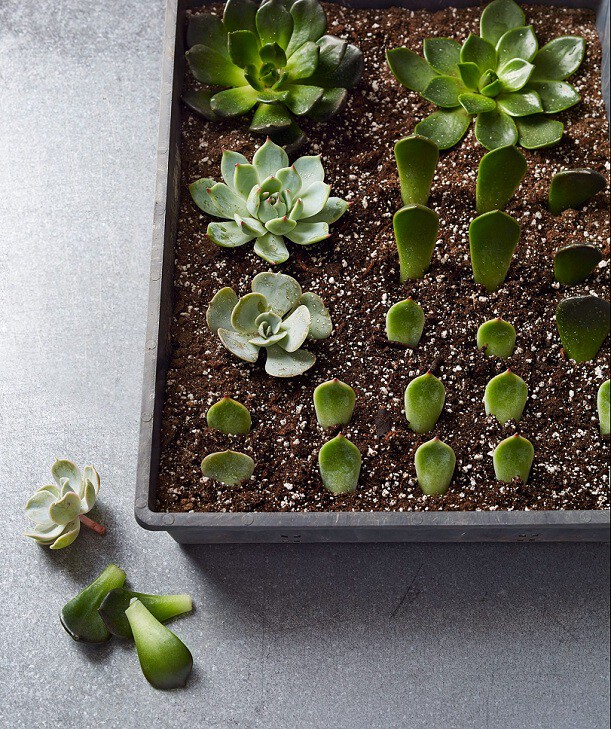Succulents are among the easiest plants to regenerate. Try this once and we bet you'll be hooked.
Succulents are the plants that keep on giving. In addition to being famously low-maintenance and endlessly charming, succulents will actually gift you with new plants. Propagation is the process of growing new plants from clippings or other plant parts. While many plants can propagate, succulents spawn easily and generously.

"Propagating succulents is a perfect project for beginning and advanced gardeners alike, as very little is required to yield rewarding results," says Nadine Kremblas, the Living Arts Lead and resident succulent evangelist at Pistils Nursery, a specialty plant shop in Portland, Oregon.
Why Should You Propagate Succulents?
Propagating succulents is the best way to fill out a pot-because the clippings are a lot more succulent than their mother plant. If you've noticed, succulents start to get leggy as they grow. And this is a good way to make sure your planters stay full and plump. Another reason to propagate? It's a very nice, personal, and inexpensive present to give to friends! Whatever your reason, as Martha says, "You can get a couple hundred dollars worth of plant off of one $9 plant! It's a very smart thing to do."
When Is the Best Time to Propagate Succulents?
Propagation can be done year-round, but you'll get the best results during the spring and summer months when succulents are actively growing, advises Kremblas. Many people choose to propagate when their succulents get "leggy." As succulents age, some lose their dense, bushy shape as they reach towards the sunlight. Pruning the plant will help maintain its shape, and these cuttings can be used to produce new plants.
How to Propagate Succulents from Cuttings
There are different ways to propagate succulents. The most widely known is by taking a cutting. This method is ideal for mature succulents that have grown too tall and become leggy. Taking a good cutting is essential for setting your new succulent up for success. "To take a stem cutting, you'll always want to use a sharp, clean blade," advises Kremblas. "A clean cut gives your cutting the best chance at survival, minimizing the chance of fungus or disease."
Take your cutting from stems that are fresh and actively growing. If you see a stem sprouting aerial roots—wispy, delicate roots shooting off the side of the stem—take your cutting here. This is a sign that this portion of the plant is ready to set out on its own. After taking your cutting, allow it to callus for three to five days before placing it in soil; this will further discourage fungus. Once the callus has formed, place your cutting in a shallow container filled with a succulent potting mix; bury the calloused end slightly in the soil without fully submerging. Whether indoors or out, the area should be warm and receive sun, but not intense light.
Resist the urge to over-water your cuttings. Even mature succulents have delicate, water-shy roots, and oversaturating can easily kill fragile propagations. Instead, use a spray bottle to lightly mist the cutting. "Rather than watering the soil directly, it's best to just spray the ends of the cutting where the root growth is expected," says Kremblas. "Avoid saturating the soil to prevent them from rotting before rooting happens." Once roots have developed, plant your new succulent in the garden or a pot.
How to Propagate Succulents from Leaves
New succulents can propagate from single leaves, too. This method works best for succulent varieties with plump, fleshy leaves that are easily removed. Although it will take considerably longer to produce a full-size plant, leaf propagation sacrifices less of the "mother" plant, and each leaf can produce multiple tiny plants. Like stem cuttings, it's important to get a good leaf cutting. Leaves can be wiggled off the plant but must separate from the plant at the base of the stem. "Be sure to get all the way down to where the leaf meets the stem, as a broken leaf will not propagate," warns Kremblas. And be sure to choose a plump, firm leaf that shows no signs of limpness.
Similar to stem cuttings, leaf cuttings should be allowed to callus and require partial sun while propagating. Place leaf cuttings directly on top of a shallow layer of succulent potting soil (do not bury) and mist with water to keep moist. Within three weeks or so, the leaf cuttings will begin to sprout tiny "pup" plants. Around eight weeks, the mother leaf will wither and fall off, and your pups are ready to be planted.
How to Propagate Succulents with Offsets
Some succulents, such as hens and chicks, spread through the garden by producing pups, which are connected to the mother by delicate roots. Often, these offshoots or pups will already have their own roots and can simply be removed from the mother and potted on their own, says Kremblas. Others may need a few weeks to develop their own roots; treat these pups like stem cuttings and plant once the roots sprout. Succulents, such as echeveria, aeonium, and jade, are easy to root from pups or leaves.
How to Propagate Sucuclents in Water
Stem cuttings and offsets can be propagated in water instead of soil. This can be a good method if you only have a small space to propagate, such as a narrow shelf. After the stem cutting or offset has callused, place it in a glass or jar of water, resting the stems on the rim to suspend the plant just above the surface of the water. Over time, it will sprout roots that reach down into the water. Keep the jar in a warm area that receives partial sun. Once roots develop, your new succulent is ready to be planted.